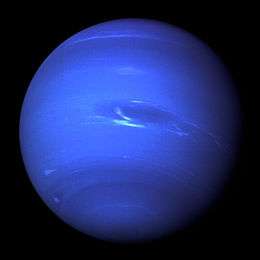Triton Hopper
 Artist's concept of the Triton Hopper | |
| Mission type | Reconnaissance |
|---|---|
| Operator | NASA |
| Spacecraft properties | |
| Spacecraft type | Robotic |
| Triton lander | |
Triton Hopper is a 2015 NASA lander mission concept to the largest Neptune's moon Triton.[1]

History
Triton is the largest moon of Neptune. In 1989, Voyager 2 flew past the moon at a distance of 40,000 km,[2] and discovered several cryovolcanoes on its surface. Triton is geologically active; its surface is young and has relatively few impact craters. It has a very thin atmosphere.
The Triton Hopper concept is being matured by NASA's Institute for Advanced Concepts (NIAC).[3]
Overview
The Triton Hopper concept proposes the use of a radioisotope rocket engine that would collect nitrogen ice on or below the surface, heat it under pressure and use it as propellant to explore Neptune's moon Triton.[3] The largest technological challenge is to learn how to mine local surface nitrogen ice, and how to heat it for use as propellant.[3] The rocket-powered hops are estimated to be up to 1 km high and 5 km long.[4]
A rocket-powered vehicle, or "hopper", has several advantages due to the variety of terrain and a gravity of only 8% of that of Earth. Hemispheric traverses and atmospheric sampling are possible during hops.[1]
While airborne, the craft could acquire images and videos during flight. While on the ground, it could photograph and analyze the chemistry and geology of the surface. It could potentially fly through geysers on Triton's surface to analyze the material ejected from them.[5]
References
- 1 2 Hall, Loura (7 May 2015). "Triton Hopper: Exploring Neptune's Captured Kuiper Belt Object".
- ↑ Gray, D (1989). "Voyager 2 Neptune navigation results". Astrodynamics Conference: 108. doi:10.2514/6.1990-2876.
- 1 2 3 "Why We Should Use This Jumping Robot to Explore Neptune". Motherboard.
- ↑ Choi, Charles Q. (17 May 2016). "This Jumping Probe Might Explore Neptune's Biggest Moon". Popular Science. Retrieved 2016-11-07.
- ↑ A Mission To Neptune’s Moon Triton Would Be Pretty Cool. Alex Kasprak, Now. Space24 June 2016.
External links
- Exploring Neptune's Captured Kuiper Belt Object, a short NASA video at YouTube
